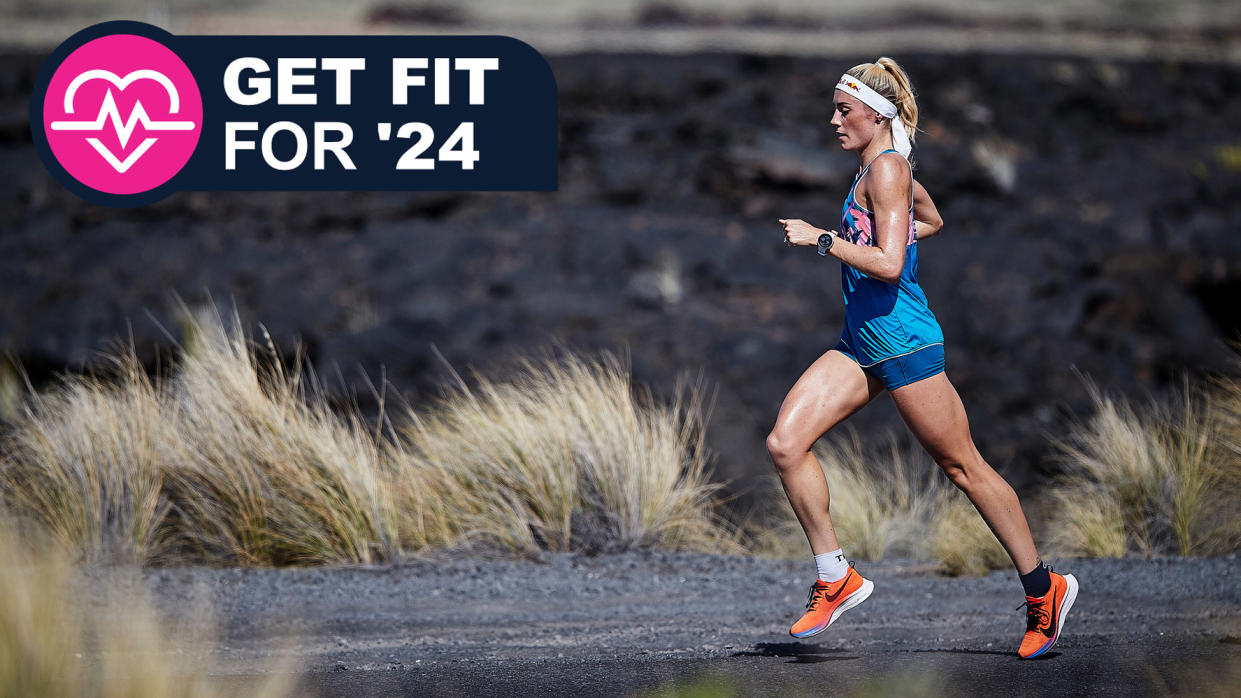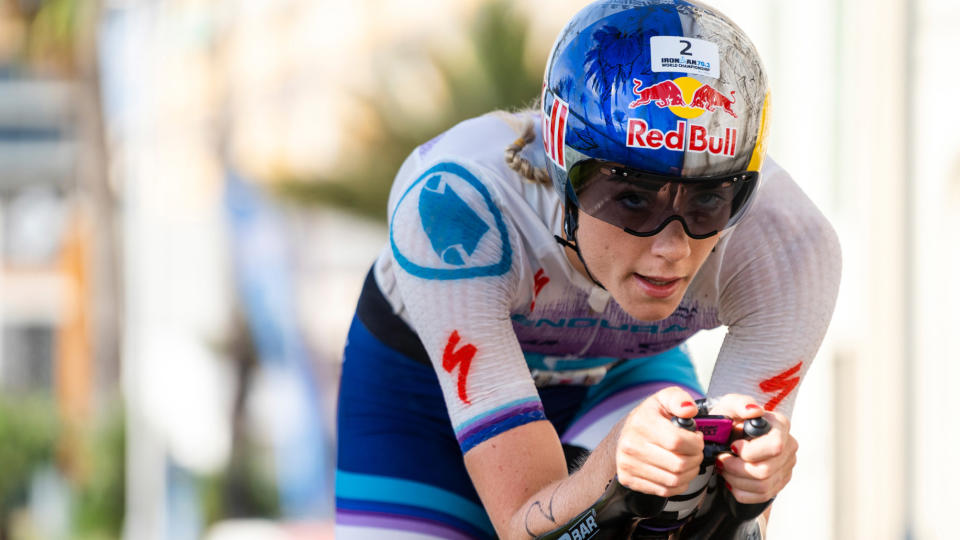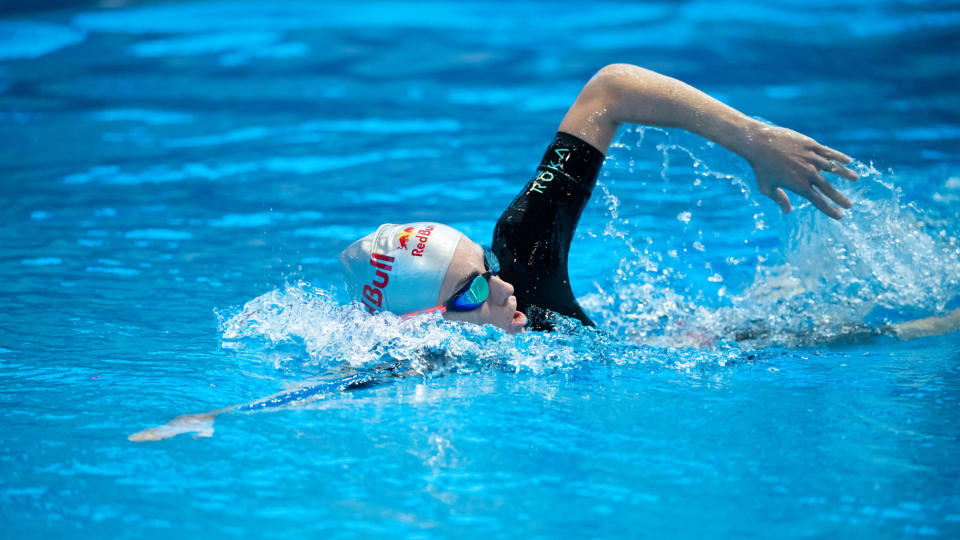'I was doing everything according to plan – I just hadn't planned for that much pain!' Here’s what it’s like to swim, cycle and run 226km in one day

I don’t know about you, but I feel quite virtuous if I can muster up the energy to squeeze a 5K run into my lunch break or get up early to do a 10-mile run on a Sunday. However, never – not even in those moments when my imagination is fueled by runners-high-induced euphoria – have I imagined myself completing an Ironman, even though I review plenty of the best running watches capable of supporting such feats. A 226-kilometer triathlon, the Ironman is one of the hardest sports on the planet and a true test of any multidisciplined endurance athlete.
Your New Year’s resolution might not be to take on an Ironman – but if you’re an experienced runner, cyclist, or swimmer, you might be interested in your first triathlon, even a short-distance one. To see off TechRadar’s Get Fit for ‘24 week in style, I chatted with Lucy Charles-Barclay, 2023 World Ironman champion, on how to get started doing triathlons – and what it takes to be a champion.
TR: For our readers, what was your sporting background before you got into triathlon and Ironman?
LCB: I started out as a swimmer when I was about eight years old, and when I was about 18, I was competing for Great Britain, mainly in long-distance swimming, so quite a lot in open water. So I was racing the five and 10k marathons to mean distances, and I was trying to make the London Olympics.
After I didn't make the Olympics, I eventually just lost the love of the sport. And anyone who has done swimming knows, it is quite a relentless sport, and there's very little reward for your hard work. So I basically gave up sport altogether, but after a while, I just really missed that dedication to training and having a big goal that you're working towards. My now-husband and I decided to sign up for an Ironman, a crazy challenge! It was a big enough goal to scare us into really training again.
We had about 11 months to train for it, and we had no equipment to do a triathlon whatsoever, so it was a very steep learning curve from the beginning – you obviously need to buy a wetsuit, all the equipment, and then you need to think about the nutrition required to complete the distance as well – so I guess that's how it all began!
TR: In that first Ironman, what did you find really challenging, and what made you want to keep doing it?
LCB: I always knew the swim would be fine because I had my background in swimming. So it was just a case of ‘do the swim’ and then the hardest part of the day for me, I always knew would be on the bike.
I was a complete novice at cycling, I'd only just bought my first time-trial bike about a month before the Ironman, which I wouldn't recommend doing to anyone! I would say make sure you've had a good few months of training on whatever equipment you're going to use on an Ironman, particularly your first one. I bought that bike secondhand on eBay. I still have it actually.
One of the scariest things was I didn't want to go from the big chain ring to the little chain ring on the climb, because I wasn't sure I'd be able to get the chain back on if it dropped off. Whereas now, that's very second nature, but at the time, it seemed like a daunting thing.
And I remember also being really nervous about getting a puncture because I thought “God, is it just gonna take me like an hour to change the inner tube?” So all of those things were my biggest worry, the mechanics of the bike.

TR: What's your preferred training watch to use during a race and why?
LCB: I currently use the Wahoo Rival watch. I use it mainly for my swim and run training. But it also pairs seamlessly with the Wahoo KickR trainer that I use for my indoor training, so I can control the trainer from the watch, or I can look at all of the data in one place from the bike computer or the watch. So because it all pairs together so easily.
I love all of the data. But I love it to be as simple as possible. For me, it's easy to upload onto various training platforms or sync my workout that my coach has sent me from TrainingPeaks: it can go directly to the watch or the bike computer.
Simplicity is key. I think when you're training as much as I am, I haven't got time for too many data pages on this. So the simpler, the better. This year, I made the switch to the Shimano power meter, which is in the cranks of your bike, and I found it to be the most consistent with my training. We also compared it to the Wahoo KickR, and they were quite similar in the power readings.
I would say one of the other things I use in my training, which I think a lot of runners and triathletes do – Strava has been something that makes my training a bit more fun. I set myself a goal this summer to try and be one of my ‘Queen of the Mountain’ times on one of the most famous climbs in Lanzarote. Although it wasn't my main goal this season, it played a really good part in a six-week camp that I was doing on the island, it gave me a little bit of an extra goal.
TR: It's all fun and games until you go back, look at your Strava, and see somebody's taken that segment off you!
LCB: Yeah! Absolutely fuming!

TR: What advice would you give people looking to take on their first triathlon? Even if it's a short one, like a sprint tri.
LCB: Although I had a swimming background, I was quite a novice when it came to cycling and running. So I did enter a sprint triathlon, then an Olympic triathlon, then a half Ironman, then an Ironman, so I worked my way up the distances to learn as much as possible.
5K Parkruns made for a really good tool, where I just go and run 5K each week to see if I could get a little bit quicker. That was a really good tool for me to try and keep it fun, but also have like a little goal along the way. And I also think like, it's really handy to have a platform like TrainingPeaks or Strava, where you can actually log your training and make sure that you're only gradually increasing it week by week.
It's also really important to have quite a clear plan of what you're doing. If you've got a busy work-family life, it can be really difficult if it's not a plan on paper. And the plan is never perfect, but I think it just helps to have a little bit of a guide rather than being like, “Oh, what should I do today with my training?" when you wake up.
TR: Finally, what's the most intense toughest moment you've ever had during a race? And how did you pull yourself through it?
LCB: Yeah, I guess probably one of the hardest things was in Kona, this year on mile one of the marathon, I felt some pretty severe pain in my calf muscle.
TR: Mile one!
LCB: Yeah, I actually said to my husband that if I had been doing just a marathon and it had happened on mile one, I probably would have stopped. However, mile one of a marathon is such a long way into an Ironman that I said to myself, “I've not come this far to not finish, and not when I had such a big lead”. So it was pretty much agony for 25 miles, but I had come second in that race four times and I knew that I had to do it this year. If I was gonna do it, it had to be this year.
Although I was in a lot of pain, I could just see each kilometer split on that run on my watch was exactly what I intended to run. So I was doing everything according to plan – I just hadn't planned to be in that much pain!
This article is part of TechRadar's Get Fit for '24 week of fitness content. To find out more about Lucy Charles-Barclay, head to her Red Bull athlete page here: redbull.com/gb-en/athlete/lucy-charles-barclay.

